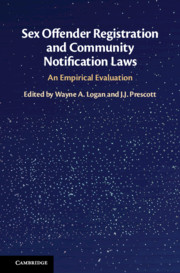Book contents
- Sex Offender Registration and Community Notification Laws: An Empirical Evaluation
- Sex Offender Registration and Community Notification Laws
- Copyright page
- Contents
- Contributors
- Preface
- Acknowledgments
- 1 Origins and Evolution
- 2 Variations in the Structure and Operation of SORN Systems
- 3 Registries and Registrants:
- 4 Law Enforcement and SORN
- 5 The Public and SORN Laws
- 6 The Ancillary Consequences of SORN
- 7 Offenders and SORN Laws
- 8 Integrating the Etiology of Sexual Offending into Evidence-Based Policy and Practices
- 9 Juvenile Registration and Notification Are Failed Policies That Must End
- Conclusion
- Index
- References
5 - The Public and SORN Laws
Published online by Cambridge University Press: 11 June 2021
- Sex Offender Registration and Community Notification Laws: An Empirical Evaluation
- Sex Offender Registration and Community Notification Laws
- Copyright page
- Contents
- Contributors
- Preface
- Acknowledgments
- 1 Origins and Evolution
- 2 Variations in the Structure and Operation of SORN Systems
- 3 Registries and Registrants:
- 4 Law Enforcement and SORN
- 5 The Public and SORN Laws
- 6 The Ancillary Consequences of SORN
- 7 Offenders and SORN Laws
- 8 Integrating the Etiology of Sexual Offending into Evidence-Based Policy and Practices
- 9 Juvenile Registration and Notification Are Failed Policies That Must End
- Conclusion
- Index
- References
Summary
Chapter 5 examines the role the public plays in passing and implementing SORN laws. It argues that understanding how the public views SORN laws and how it uses registry information is critical to reform efforts. The chapter begins with SORN laws’ roots in public opinion toward individuals convicted of sexual offenses. High-profile crimes drive the public’s strong and consistent support for SORN laws. However, altruistic fear rather than fear of personal victimization accounts for this support. The chapter also examines how people use publicly available registries. Studies indicate that only a minority of people access sex offender registries. Moreover, those who do access registry information do so primarily out of curiosity. Further, it is at best unclear whether registries induce users to take protective actions likely to reduce their risk of victimization – and whether registries even make people feel safer. The chapter concludes by arguing that the public’s opinion about SORN laws turns ultimately on what the public intends them to accomplish. If public safety plays any role, public support may wane over time. Given the public’s modest use of registries, it may be time to rethink public registries and prioritize providing actually useful information to the public.
Keywords
- Type
- Chapter
- Information
- Sex Offender Registration and Community Notification LawsAn Empirical Evaluation, pp. 59 - 77Publisher: Cambridge University PressPrint publication year: 2021



